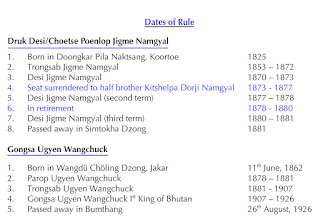Something that is puzzling is that Jigme Namgyal is more famous as Trongsa Poenlop – rather than as Druk Desi. The fact is that he served as Druk Desi three times in his lifetime. In fact he died as Druk Desi and not as Trongsa Poenlop.
Another historical injustice is that he should be even more famous as the true unifier of Bhutan – not Zhabdrung Ngawang Namgyal or Choetse Chila Chhogyal Mingyur Tempa. The process of unification of Bhutan into a single nation state was certainly initiated by the Zhabdrung, upon appointment of Chhogyal Mingyur Tempa as the Choetse Chila in 1646/47 (records recently unearthed point to the fact that he was already Choetse Chila by 1643). Chhogyal Mingyur Tempa did manage to unify Sharchog Khorlo Tsipgye under the central rule, by 1654. However, the unification did not last long – it disintegrated after Chhogyal Mingyur Tempa was appointed the 3rd Druk Desi and relocated to Punakha, in 1668.
It was Jigme Namgyal who re-integrated Sharchog Khorlo Tsipgey into the central rule seated at Punakha and re-established Bhutan as a single nation state – in the year 1850. When he did so, he was not the Trongsa Poenlop – he was then the Trongsa Droenyer, under Trongsa Poenlop Tshoki Dorji.
Jigme Namgyal became Trongsa Poenlop in 1853 and administrated Sharchog Khorlo Tsipgey which included the whole of central and eastern regions, such as Mangde, Jakar, Zhemgang, Lhuentse, Zhongar, Trashigang, Trashiyangtse and Doongsam. For all practical purposes, Jigme Namgyal was the de-facto ruler of Bhutan – and not the Druk Desi.
For a short while his territorial jurisdiction was halved – when Sharchog Khorlo Tsipgye was split into two and one half was handed over to Jakar Poenlop Tsuendrue Gyaltshen. That did not last long though - Jakar Poenlop Tsuendrue Gyaltshen was killed in the famous Duars War with the British, in 1865. Upon the demise of Jakar Poenlop, the whole of Sharchog Khorlo Tsipgye reverted back to the rule of the Trongsa Poenlop.
His son Paro Poenlop Ugyen Wangchuck became Trongsa Poenlop upon his demise in 1881.
Few are aware that Gongsa Ugyen Wangchuck was not the first-born of Druk Desi Jigme Namgyel – he was the second son, born after Thinley Tobgyal, the first-born.
The measure of the importance of Trongsa Poenlop Ugyen Wangchuck can be judged from the fact that it was him who was invited to Calcutta by British India government - to meet the Prince and Princess of Wales - later King George V and Queen Mary, in 1906. By protocol, it should have been the Druk Desi who should have represented Bhutan, during the official visit of the British royalty to colonial India.
By tradition, all the holders of the Golden Throne have to be first seated at Choetse, as the Choetse Poenlop. His Majesty the Third King Jigme Dorji Wangchuck has the distinction of being the only King of Bhutan who never had the opportunity to become Trongsa Poenlop – he ascended the Golden Throne directly while he was still the Paro Poenlop, in 1952.



No comments:
Post a Comment